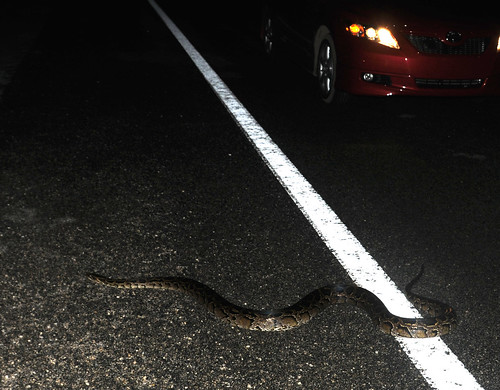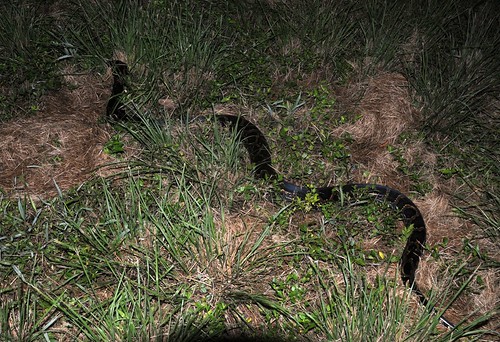At last I get to a post I've been hoping to make for quite a while. Ever since I heard that a population of Burmese Pythons (Python molurus bivitattus) had established itself in southern Florida I was keen to go look for and photograph them. My first effort failed miserably but I went back recently. As most nature-lovers have probably heard this colony established itself due to releases by irresponsible pet-owners. About as irresponsible as it comes in fact - Burms are huge, among the largest snakes in the world and capable of getting up close to the 20 foot mark. In nature they are aggressive ambush predators willing to attack pretty much anything - we've all seen that alligator photo after all. So its potentially a disaster although how bad it will be we don't really know and some of the news coverage of the issue has represented scaremongering of the worst form.
If you want to find pythons a little online research will hook you up with better details than I can provide of how to do it. Suffice it to say if you go looking bear in mind a) the laws of the national park, b) other much smaller animals in the same area (I came across an array of awesome visual bycatch including 5 nocturnal bird species, 10 snake species and a coyote) and c) your own safety. Anyway I found one (just outside Everglades National Park if anyone is interested) and here it is posing with a Toyota Camry for scale.
If you want to find pythons a little online research will hook you up with better details than I can provide of how to do it. Suffice it to say if you go looking bear in mind a) the laws of the national park, b) other much smaller animals in the same area (I came across an array of awesome visual bycatch including 5 nocturnal bird species, 10 snake species and a coyote) and c) your own safety. Anyway I found one (just outside Everglades National Park if anyone is interested) and here it is posing with a Toyota Camry for scale.

Its worth noting that upon first seeing it I immediately thought python but then briefly pondered whether I'd come across the mother of all eastern diamondback rattlesnakes due to its tail shape and patterning. It was keen to be away from me but not bitey which was a pleasant surprise. Notwithstanding that a look from this dogfaced head gives one pause for thought in getting closer.

Collecting or controlling a snake this size is definitely a job for someone who knows what they are doing (and really to be truly safe this is something that should only be attempted when you have someone to act as back-up). Eradicating this population is going to be a collossal task. Burms are a lot faster on land than anaconda and in this scrub it was moving pretty quick. Its perhaps worth noting that African Rock Python, Anaconda and Boa Constrictor have all been found in the wild in Florida too (along with a few other unconfirmed tales of more ridiculous giant reptiles still) but these species appear to not be expanding their populations with the same success which is lucky. Burms are obviously well adapted for these conditions - I'd be pretty worried about a population of reticulated pythons if one were found (I think they'd be supremely suited to the 'glades) but I suspect temperature will prove a limiting factor if such a thing were to happen.
As you can see these guys have beautiful patterning. Below is the last shot I have of this beast. Immediately after I took it I walked away to deal with something briefly with the intention of coming back for more shots. When I returned 30 seconds to a minute later this huge snake had managed to completely disappear. Which is kind of scary.


5 comments:
It is a beautiful animal,but I'm sorry to say, you should have done the right thing and run it over.
My first python in the glades was over 11 feet long and found crossing the road at night.At that time I didn't know for sure what the protocol was for dealing with these guys in a national park.We had also just seen my first panther and this snake was much more ominous.
Have since been advised that procedure is to dispatch the animal -and if running it over to aim for head or internal organs.
I am an animal lover and it will make me cry to have to kill one but I understand the reasons.
They are beautiful creatures. I'd say exceptionally beautiful in their native habitat. But what frightens me are photos like what's in the link you provided and the one in this USGS article (http://www.usgs.gov/newsroom/article.asp?ID=1875). Oh, and the environmental suitability maps at the end of that USGS article are more than troubling...
Still, I'm glad your quest to see one was successful. And an impressive specimen it was, too!
"Have since been advised that procedure is to dispatch the animal -and if running it over to aim for head or internal organs."
my understanding is that because of the protection of all animals in national parks (notwithtanding the ridiculousness of applying that here) this would technically be illegal in ENP itself. Not sure how it would play out long term but its probably best for those likely to encounter them regularly to get formal approval from the python team to deal with these guys rather than go it alone.
PS very jealous of your panther - I thought briefly I saw one but it turned out to be a big panther-coloured dog
Technically you are correct,which is why I hesitated the first time.
Since then I had posed the question to a well positioned park official and was told it was allowed.
Of course I do have park biologists on speed dial too.
There is a story out there about a very large python being dispatched immediately after the under secretary of interior almost stepped on it while on a visit.
After it was examined it was found to be one of the "Jonah" snakes! Hopefully they salvaged the transmitter.
The large mowers get lots of them on the roadsides in the winter,thus providing a food source to the raptors that have suffered the loss of the marsh rabbit population (from snake predation)
Post a Comment